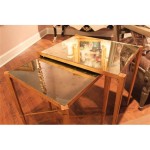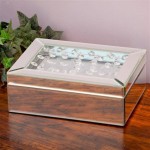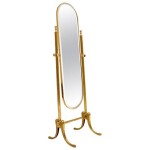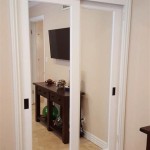Best Wall To Put a Mirror On
Mirrors are more than just reflective surfaces; they are versatile design tools that can dramatically impact a room's aesthetics and functionality. Choosing the right wall to hang a mirror involves careful consideration of various factors, including the room's layout, natural light sources, and desired visual effects.
Key Considerations for Mirror Placement
Several factors influence the ideal placement of a mirror within a room. Understanding these elements allows for informed decisions that maximize the mirror's positive impact.
1. Amplifying Natural Light
One of the most common uses of mirrors is to enhance natural light within a space. Placing a mirror on a wall opposite a window can effectively reflect sunlight deeper into the room, brightening dimly lit areas and creating a sense of spaciousness. This strategy is particularly beneficial in smaller rooms or those with limited natural light sources.
2. Creating a Focal Point
Mirrors can serve as striking focal points within a room. Positioning a large, ornately framed mirror on a prominent wall can draw the eye and anchor the space. This approach works well in entryways, living rooms, or dining areas where a statement piece can elevate the overall design.
3. Enhancing the Sense of Space
Strategically placed mirrors can create an illusion of depth and spaciousness, particularly in smaller rooms or narrow hallways. Placing a mirror on a long wall can visually extend the length of the space. Similarly, using mirrors to create a mirrored wall can dramatically open up a room, making it appear larger than its actual dimensions.
4. Reflecting a View
If a room offers a pleasing outdoor view or an attractive interior feature, positioning a mirror to reflect this view can enhance the aesthetic appeal of the space. This strategy brings the outdoors in or highlights an existing design element, adding visual interest and depth.
5. Practical Considerations
Functionality also plays a role in mirror placement. In bathrooms, mirrors are essential for grooming and should be positioned appropriately above vanities or sinks. In bedrooms, full-length mirrors are often placed on closet doors or walls for dressing convenience.
Mirror Placement in Specific Rooms
Different rooms benefit from specific mirror placement strategies based on their function and design goals.
1. Living Room
In living rooms, mirrors can be used to enhance natural light, create a focal point, or reflect an attractive view. Placing a mirror above a fireplace mantel can add a touch of elegance, while positioning a large mirror on a wall opposite a window can brighten the space and create a sense of airiness.
2. Dining Room
Mirrors in dining rooms can create a sense of grandeur and enhance the ambiance. A large mirror reflecting a chandelier or a beautifully set table can amplify the visual appeal of the space and create a more formal atmosphere.
3. Bedroom
In bedrooms, functionality and aesthetics are key considerations for mirror placement. Full-length mirrors are essential for dressing and can be placed on closet doors or walls. Smaller decorative mirrors can be used to enhance the décor and create a more personalized space.
4. Bathroom
Bathrooms require mirrors for practical purposes, such as grooming and hygiene. Mirrors should be positioned above vanities or sinks at a height that is comfortable for users. The size and shape of the mirror should complement the size and style of the bathroom.
5. Entryway
Entryways can benefit from strategically placed mirrors. A mirror near the entrance allows for quick appearance checks before leaving the house. Furthermore, mirrors can brighten and visually expand smaller entryways, creating a welcoming impression.
Avoiding Common Mirror Placement Mistakes
While mirrors offer numerous design benefits, certain placement choices should be avoided to prevent undesirable effects.
1. Reflecting Clutter
Avoid placing mirrors in positions that reflect clutter or unattractive areas of the room. This can create a sense of disorganization and detract from the overall aesthetic.
2. Placing Mirrors Too High
Hanging mirrors too high on a wall can make the room feel unbalanced and awkward. The center of the mirror should generally be at eye level for optimal viewing.
3. Overusing Mirrors
While mirrors can enhance a space, overusing them can create a chaotic and disorienting environment. Use mirrors judiciously and focus on strategic placement for maximum impact.
4. Ignoring the Room's Style
The style of the mirror should complement the overall design of the room. A modern, minimalist mirror might look out of place in a traditional setting, while an ornate antique mirror might clash with a contemporary aesthetic.
By carefully considering these factors, individuals can effectively utilize mirrors to enhance the functionality, aesthetics, and overall atmosphere of their living spaces.

The Best And Worst Places To Hang Mirrors In Your Home American Art Decor Americanartdecor Com
:strip_icc()/Design_CathieHongInteriorsPhoto_ChristyQPhotography-1f0a7254eb7a435aa80046b0bf60d33b.jpg?strip=all)
10 Feng Shui Rules For Mirrors According To Experts

What Are Some Suggestions For Arranging Mirrors In The Bedroom Quora

6 Ways To Use Mirrors Make Your Home Feel Bigger And Brighter
:strip_icc()/Designer_KatieHackworthPhotographer_BelatheePhotography1-5ec16af89e9242cabd3c637c7eb23d4b.jpg?strip=all)
10 Feng Shui Rules For Mirrors According To Experts

6 Ways To Use Mirrors Make Your Home Feel Bigger And Brighter

5 Mirror Vastu Placement Tips For A Happy Home Livspace
:strip_icc()/LightDwell-3095c5279d0b4511b10d154f3a21a9b7.jpg?strip=all)
10 Feng Shui Rules For Mirrors According To Experts

How To Hang A Large Or Heavy Mirror

Mirror Decoration For Home 15 Ideas To Decorate With Mirrors








